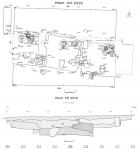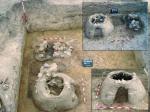Summary (English)
PLISKA (Pavel Georgiev – pavel_g@gbg.bg, Tihomir Tihov, Gergana Ilieva) In Trench XXI, the upper stratum of the 10th – 11th centuries AD was entirely excavated. A Christian burial of a young man was discovered. Querns were discovered in Houses Nos. 2, 3A and 12. An anonymous Byzantine follis of the Class A1 (AD 969 – 976), which was an overstruck follis of Nikephoros II Phokas, was discovered beneath the floor of House No. 2, providing a terminus post quem for its construction. Sherds from glazed pottery indicate that the house existed in the first decades of the 11th century AD. The early sunken-floored building was situated beneath the structures of the 10th – 11th centuries AD; its eastern part was beneath Bath No. 2. The sunken-floored building consisted of three parallel rooms arranged in a line, without entrances between each other, and an antechamber longitudinally located in front of them. Postholes were documented. The walls were faced with wooden boards and vertical posts that were placed over horizontal wooden beams dug into the floor. A stone stove and a clay domestic oven situated close to each other were discovered. The building was ridge-roofed. The finds included bone awls, fragments from bricks and roof-tiles, a fragment from a tegula with an incised letter: Y (a sacred proto-Bulgarian symbol), sherds mostly from pots, but also from a jug and a pitcher-amphora, bones from sheep/goats, birds and fish. Judging from the pottery, the building existed during the first half of the 9th century AD, but it was built after the Small Timber Fortification was destroyed in AD 811 by the Byzantine army led by Nikephoros I Genikos.
- Pavel Georgiev - Shumen Branch of the Archaeological Institute and Museum
- Tihomir Tihov - Regional Museum of History – Shumen
- Gergana Ilieva - Regional Museum of History – Shumen
Director
- Gergana Ilieva - Regional Museum of History – Shumen
- Pavel Georgiev - Shumen Branch of the Archaeological Institute and Museum
- Tihomir Tihov - Regional Museum of History – Shumen
Team
Research Body
- Regional Museum of History – Shumen
- Shumen Branch of the Archaeological Institute and Museum






![Download [PDF]](/excavation/skins/fasti/images/results/download_sml.png)

